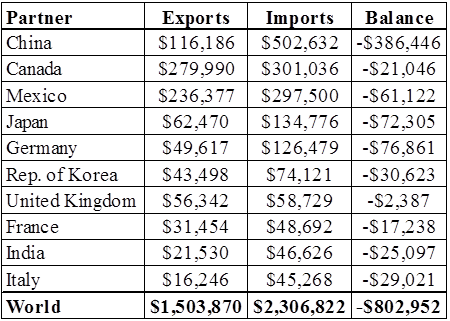Introduction
We have heard a lot of “loose” statements from Trump on what he will do to countries “cheating on trade” when he becomes President. In this piece, I examine the underpinnings of his assertions and speculate on what his trade policies will actually be when he becomes President.
Largest US Trade Partners
Table 1 lists the US’ ten largest trading partners based on the total of imports and exports. The US is running a deficit with all of them. But there is a positive side to this: American consumers have benefited from these imports: better prices and higher quality products than were available from US-produced goods.
Table 1 – US: Largest Trading Partners, 2015 (mil. US$)

Stated Policies
Here are some of the actions Trump says he will take as listed on his website:
- Appoint tough and smart trade negotiators to fight on behalf of American workers;
- Direct the Secretary of Commerce to identify every violation of trade agreements a foreign country is currently using to harm our workers, and also direct all appropriate agencies to use every tool under American and international law to end these abuses;
- Withdraw from the Trans-Pacific Partnership, which has not yet been ratified;
- Eliminate Mexico’s one-side backdoor tariff through the VAT and end sweatshops in Mexico that undercut U.S. workers;
- Instruct the Treasury Secretary to label China a currency manipulator;
- Threaten to levy 45% import duty on all countries manipulating currencies;
- Instruct the U.S. Trade Representative to bring trade cases against China, both in this country and at the WTO.
- Use every lawful presidential power to remedy trade disputes if China does not stop its illegal activities, including its theft of American trade secrets – including the application of tariffs consistent with Section 201 and 301 of the Trade Act of 1974 and Section 232 of the Trade Expansion Act of 1962.
Trump’s Misconceptions
a. US Manufacturing Jobs Lost Overseas
Trump: You go to New England, Ohio, Pennsylvania, you go anywhere you want, and you will see devastation where manufacturing is down 30, 40, sometimes 50 percent.
There are people who wish I wouldn’t refer to China as our enemy. But that’s exactly what they are. They have destroyed entire industries by utilizing low-wage workers, costing us tens of thousands of jobs….
Trump clearly attributes these job losses to unacceptable policies of other countries.
This verges on being complete nonsense. As I have been reporting since 2011, most US manufacturing jobs have been lost to labor-saving automation. A recent McKinsey Global Institute study concluded:
Trade and outsourcing explain only about 20 percent of the 5.8 million manufacturing jobs lost during the 2000-10 period; more than two-thirds of job losses can be attributed to continued productivity growth, which has been outpacing demand growth for the past decade.
And on jobs lost overseas, it is also important to consider jobs gained from overseas investments in the US. Why? Because foreign direct investment in the US generates US jobs. These investments have averaged $185 billion annually since 2000.
b. The US Trade Deficit
Trump: We have a trade deficit with Mexico of $58 billion a year. I don’t like trade wars when we’re losing $58 billion a year. Mexico is taking our businesses.
Question: How can the US run such large trade deficits without the dollar losing value?
Trade deficits means more dollars are being paid out than in. This means the supply of dollars on world markets is growing. Should not this increase in dollar supply weaken the dollar? It should. Why has that not happened? Because as I have noted, the US is selling something else the world wants that is not reflected in its trade deficit. It is selling the rest of the world US public and private debt, private equities and other US financial securities.
While these are some of the best US “exports”, they are not defined as such in trade accounts. However, it is their sales, sometimes totaling more than the US trade deficit, that keep the dollar from weakening.
c. China’s Currency Manipulations
In an interview with the New York Times editorial board, Trump said he would support a 45 percent tariff on Chinese exports to the United States. The Wall Street Journal reported:
Donald Trump says he’ll declare soon after he takes office that China is a currency manipulator because it is devaluing the yuan against the dollar.
There is no question that starting in 2002, China launched a program to weaken its currency and in turn stimulate its exports by purchasing US government debt. Between 2002 and 2011, China’s holdings of US Treasuries increased from $310 billion to $1.2 trillion. Now, part of that buildup was prudent portfolio management. US Treasuries were and remain extremely safe investments. And at least at the beginning of the period, their yields were generous.
The policy worked. Driven by rapidly growing exports, the Chinese economy grew at an extremely rapid rate so that today, it is second only (GDP $11 trillion) to the US (GDP $19 trillion) as the world’s largest economy. But times have changed. China is transitioning from being an export-led economy to one driven by the demand of the rapidly growing middle class.
This, coupled with the belief that the US Fed will increase interest rates shortly, has led to a weakening in the Chinese currency to the point that the Chinese government is attempting to keep its currency from weakening further by selling Treasuries.
In February, China’s Treasury holdings were $1.25 trillion. By September, their holdings had fallen to $1.16 trillion, meaning the government has sold off $90 billion of Treasuries. Bloomberg also reports a significant sell-off in equities held by the Chinese.
In short, the Chinese government is now taking steps to strengthen their currency, even though these actions will weaken the competitive position of its exporters. Times have changed and Trump’s picture of China is woefully out of date.
d. Getting Back at Countries Abusing Free Trade
I think our current deals are a disaster. I’m a free trader. The problem with free trade is, you need smart people representing you. We have the greatest negotiators in the world, but we don’t use them. We use political hacks and diplomats. We use the wrong people.
Trump seems oblivious to the fact that most of what he is recommending is already being done. The General Agreement on Tariffs and Trade (GATT) was established in 1948 and was replaced in 1995 by the World Trade Organization (WTO). The mission of the WTO is to “negotiate the reduction or elimination of obstacles to trade.”
It is not as if the US has not been active, both as a complainant or defendant. Since its formation in 1995, there have been 514 complaints lodged with the ITO. In 109 of these cases, the US has been the complainant. There have been 129 complaints lodged against the US. China joined the WTO in 2001.
Since then, there have only been 37 complaints lodged against China. Apparently, US lobbyists have been quite effective in getting the US government to “look the other way” and allow the US companies they represent to engage in practices antithetical to free trade.
The New “What Will Trump Do” Pundit Industry
I concede, this article is yet another in a growing number of pieces speculating on what Trump will do. As another good example, I offer a piece by Joshua Rodriguez appearing in AO Markets. He writes about Global Ship Lease (NYSE:GSL), a shipping company that, like most shipping companies, has not recovered from the 2008 collapse and related problems. Now, I know nothing about GSL or the shipping industry. But Rodriguez speculates:
Global Ship Lease has been in the midst of a rally fueled by Donald Trump. The reason for this is relatively simple. Essentially, the shipping industry, and pricing within it is largely state controlled. This is the result of several trade agreements between the United States and other nations. However, Donald Trump has rallied the troops by saying he was going to change these agreements. Trump wants to bring the free market into any industry the United States is part of, including shipping. Ultimately, this will likely lead to heavy inflation in the shipping sector, helping GSL climb in the market.
Will this really happen? Who knows? But it makes good fodder for financial writers.
Conclusions
A good part of Trump’s announced “attack” trade policy is based on the misconceptions explained above. His image of the US as the “good guys” being attacked by other nations is simply not the case, as witnessed by the number of complaints filed against the US at the WTO. When he assumes office, he will have to face realities. And much of what he says needs to be done is already happening.
But a lot of what Trump is saying is based on his negotiating approach that has worked for him in the private sector – make an outrageous threat and negotiate from back that position. Will it work for him as President? We hear Trump is a good listener. I hope so.
Correction on Trump’s claim – The Mexican Value Added Tax (VAT) is not discriminatory. It operates like a general sales tax; it is levied on all goods sold in Mexico – both domestically produced and imported.
